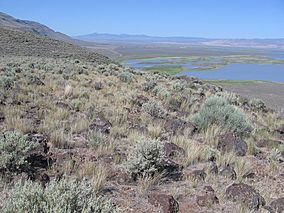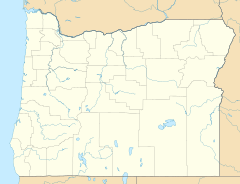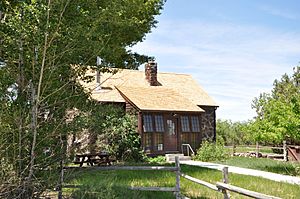Hart Mountain National Antelope Refuge facts for kids
Quick facts for kids Hart Mountain National Antelope Refuge |
|
|---|---|
|
IUCN Category IV (Habitat/Species Management Area)
|
|

Warner Valley from Hart Mountain, looking southwest
|
|
| Location | Lake County, Oregon, USA |
| Nearest city | Lakeview |
| Area | 270,608 acres (422.825 sq mi; 1,095.11 km2) |
| Established | 1936 |
| Governing body | U.S. Fish and Wildlife Service |
| Website | Hart Mountain National Antelope Refuge |
The Hart Mountain National Antelope Refuge is a special place in southeastern Oregon. It's a National Wildlife Refuge found on Hart Mountain. This huge area protects over 422 square miles (1,090 km2) of land. More than 300 types of wildlife live here. You can find animals like pronghorn, bighorn sheep, and mule deer. Many birds, such as sage grouse, and fish like the Great Basin redband trout, also call it home.
The refuge started in 1936. Its main goal was to protect the small groups of pronghorn that lived there. The land here changes a lot, from dry high deserts to shallow, temporary lakes called playa lakes. It is one of the biggest wildlife areas where farm animals are not allowed.
Contents
Why Hart Mountain is Protected
When the refuge first began, it focused on protecting antelope. Now, its mission is much bigger. It helps protect all the amazing wildlife that lives in this high desert habitat. The refuge also works to bring back native plants and ecosystems. This way, everyone can enjoy, learn from, and appreciate this special place.
A former Supreme Court Justice, William O. Douglas, once spoke about how important this protected area is:
I always feel sad leaving Hart Mountain. Yet after I travel a few hours and turn to see its great bulk against a southern sky my heart rejoices. This refuge will leave our grandsons and granddaughters an inheritance of the wilderness that no dollars could recreate. Here they will find life teeming throughout all the life zones that lead from the desert to alpine meadows.
—Justice William O. Douglas, My Wilderness: The Pacific West, 1960
He meant that this wild place is a gift for future generations. It's something money can't buy or create again.
Fun Things to Do at the Refuge
There are many ways to explore and enjoy the Hart Mountain National Antelope Refuge. Remember, it's a wild place, so be prepared!
Wildlife Watching and Photography
- Watching and photographing wildlife are the most popular activities.
- You can find special hidden spots called "blinds" to watch animals without disturbing them.
Hiking and Backpacking
- Hiking is encouraged, but there are no marked trails.
- You can hike across the land, which is called cross-country hiking.
- To see the most remote parts of the refuge, backpacking is the best way.
Camping at Hart Mountain
- Camping is free here, but you cannot make reservations.
- There's a limit of 14 days for camping.
- Loud equipment like generators are not allowed.
Biking and Fishing
- You can ride bikes on roads that are open to cars.
- The roads are rough, so you'll need a strong bike.
- Fishing is allowed in a few spots if you have an Oregon fishing license.
Rock Collecting
- You can collect rocks, but only up to 7 pounds (3.2 kg) per day.
- Only pick up rocks from the surface; digging or blasting is not allowed.
- Nearby, you can find Sunstone, which is Oregon's state gemstone.
Getting Around and Services
It's important to know that none of the roads in the refuge are paved. Most roads are just dirt tracks, sometimes called "jeep trails." Many are not suitable for regular cars.
There are almost no services inside the refuge. At the headquarters, you can find compressed air, drinking water, and a restroom.
Nearby Towns and Supplies
- The closest places for gas and groceries are Plush, about 25 miles (40 km) west, and Frenchglen, about 50 miles (80 km) east.
- Lakeview is the nearest city with more services. It's about 65 miles (105 km) southwest. In Lakeview, you can find car repair, places to stay, and medical care.
- You can also find places to stay in Frenchglen.
Amazing Wildlife of Hart Mountain
The different types of land in the refuge support many kinds of wildlife. It's a busy place!
Animals You Can See
- There are 239 different kinds of birds.
- You can find 42 types of mammals.
- At least eight kinds of reptiles live here, including rattlesnakes, bull snakes, and various lizards.
Year-Round Residents
Some animals stay in the refuge all year long. These include:
Seasonal Visitors
Most birds visit the refuge during certain seasons. You might see:
- Golden eagles
- Sandhill cranes
- Colorful sage grouse
- Many other birds that migrate through the area.
Pronghorn and Bighorn Sheep
- The pronghorn is North America's fastest land animal. They can run up to 45 miles per hour (72 km/h)! You can see them running freely across the sagebrush plains on the east side.
- Bighorn sheep prefer the rocky cliffs on the west side of the refuge.
- Many shallow lakes and grassy meadows fed by springs attract the most different types of animals.
Bighorn Sheep Reintroduction
Sadly, by 1915, bighorn sheep had disappeared from this area due to disease and hunting. But in 1954, efforts began to bring them back. New sheep were brought from British Columbia. Now, there are about 300 bighorn sheep living in the refuge.
Cattle Grazing Changes
In the past, cattle grazed in the refuge. This caused problems like:
- Too much grass being eaten (overgrazing).
- Stream banks wearing away (eroded).
- Springs being trampled.
- Aspen tree groves being damaged.
- Wildlife habitats being destroyed.
Because of these problems, cattle grazing was stopped in the refuge in 1994. A study in 2015 showed how much the land has recovered since then. Plants like aspens, rushes, and willows have grown back. The areas along rivers and streams have also been restored.




